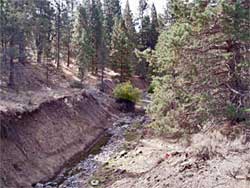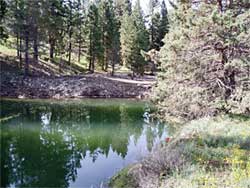Home » Programs » January 2008 Watershed Highlight: Pit Resource Conservation District
January 2008 Watershed Highlight of the Month
Pit Resource Conservation District

Above: Pre construction view of Rose Creek.

Above: Post construction view of Rose Creek.
|
The January 2007 Watershed Highlight goes to the Pit Resource Conservation District (RCD) in Modoc County for the implementation of their Rose Creek Canyon Project. Rose Creek Canyon is a tributary to
the Pit River, a major tributary to the Sacramento River. Like many tributary streams and associated meadows in the region, Rose Canyon Creek is deeply incised and contributes large amounts of sediment
downstream into its lower reaches and eventually into the Pit River. The incised channel and sediment issues in Rose Creek Canyon have a direct effect on habitat values within the meadow, downstream in
the creek, and in Pit River. The incisement has resulted in the transition from meadow vegetation (e.g. grasses and sedges) to a sagebrush community with occasional trees (e.g. western juniper and pine)
as well as water table degradation. The stream channel had narrowed and consisted of more shallow water habitat. Additionally, substrate within the channel lacked habitat diversity.
Several occurrences in the last century have resulted in Rose Creek Canyon changing course and building a new, deeply incised channel. These occurrences have included debris flows from a fire in the
late 1940s, and more recently, debris flows from the 1997 floods. Grazing and road use may also have affected the channel stability.
Recently, local landowners and the Pit RCD partnered to restore Rose Creek Canyon to its original channel, reduce the loss of land and sediment downstream, and restore meadow vegetation. This was achieved
by implementing the “pond and plug technique.” Cooperative agencies (i.e., U.S. Forest Service, U.S. Fish and Wildlife Service, Natural Resource Conservation Service), and private partners (i.e., Rocky
Mountain Elk Foundation, Lookout Livestock Association) also assisted with permitting, technical assistance, and funding. Other grant monies used to implement the project included Proposition 13, EPA
319h, and USFWS Partners for Wildlife.
Congratulations to Pit RCD on the success of this important project!
|

